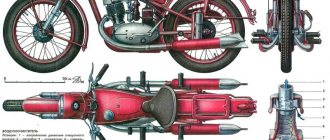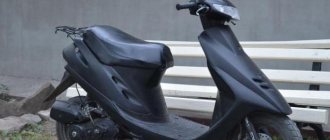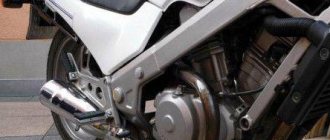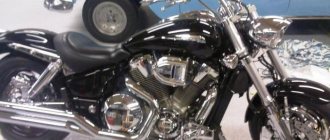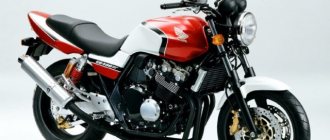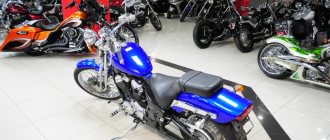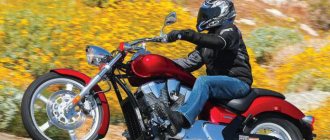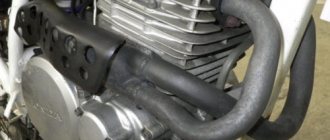The Japanese motorcycle Honda VRX 400 is another attempt by the automotive industry giant to combine a classic model and a cruiser. The modification did not gain much popularity: its release lasted only 4 years (from 1995 to 1999). Against the backdrop of competition, the motorcycle in question from Japan gave way to more powerful analogues and traditional “classics”. In fact, it turned out to be quite a noble motorcycle, incorporating the best of its predecessors.
Exterior
Externally, the Honda VRX 400 Roadster is stylized to resemble the 70s. The unusual V-shaped power unit from Steed adds stylishness and impressiveness to the exterior of the motorcycle. The vehicle in question had four color variations: red, blue, black with chrome inserts, and completely black.
Working metal parts are chrome plated. The exhaust system is bifurcated and expands towards the exit, which adds additional aggressiveness, but in moderation. The bike itself is quite narrow, which gives it the advantage of city riding. The driver's part of the seat is slightly recessed, the steering wheel is of a standard shape with instrument indicators, a control system, a round headlight and turn signals placed on it.
For whom
Here are the main features of the Honda VRX 400 Roadster:
- stylish exterior;
- calm character;
- A V-twin engine that looks appropriate, but somewhat strange.
This bike will be of interest to those who love a variety of motorcycle hybrids. Often such combinations turn out to be unsuccessful, at least in terms of design, but this model boasts a well-thought-out design.
Running performance
In contrast to its retro appearance, the ride quality of the Honda VRX 400 is one hundred percent cruiser-like. The efficient “Stead” power unit produces 33 horsepower with a torque of 34 nm. The five-speed gearbox with long gears allows you to shift quite rarely. At the same time, you can safely start from third position, and engage fifth even at 60 km/h. The possibility of dynamic acceleration is not lost in this case; it is enough to increase the gas supply by turning the corresponding knob.
A considerable part of the structural parts are borrowed from the Steed model:
- Carburetor.
- Chain drive.
- Rear wheels.
- Engine and a few other elements.
But the braking system of the motorcycle in question from Japan is much more effective than that of its brother. This is due to the rear brakes being equipped with a disc mechanism. Also, an original tubular steel frame was created specifically for this “bike”.
Review of the Honda VRX 400 Roadster motorcycle
Anyone who is looking at this motorcycle must determine for themselves the purpose of the purchase and realistically assess their desires and its capabilities. This is almost the perfect motorcycle for beginners. He is friendly, does not rush off like a young stallion. The speed picks up smoothly. The seating position is very comfortable. Review too. Medium height saddle.
It is also suitable for those who previously had IL or Java. A classic, he is a classic.
This is not an enduro - it is too soft for potholes and bumps with the standard suspension. For comparison: the VRX has a little more than 10cm of suspension travel, and the Transalp has more than 17cm.
The maximum speed to which the VRX can be accelerated is 130-140 km/h. The optimal speed is in the range of 80-110 km/h. At the same time, the most economical mode is 80-90 km/h. Whether it’s a little or a lot, everyone decides for himself based on the same proportion of what is desired and what is actual. As for me, these speeds are quite enough for driving with pleasure. During operation, people often came up to me and asked what was going on - I honestly answered that the cubic capacity was small, 400 cc, and it also didn’t go relatively fast - most often on the highway it was 110-120. I don't speed up anymore. And they reasonably asked me, “Why more?” That's the truth - why?
Public roads are not a testing ground for generating adrenaline. There are activities that are much more suitable for this. Bungee jumping, skydiving, rafting, kayaking, yachting, etc. At the same time, you decide whether to take risks or not, to get adrenaline or not. Without a threat to others, without a threat to their lives.
Pros:
- very good and stable engine operation at low speeds - comfortable seating - reliable engine - no problems with spare parts - reasonable price (on average 100-120 thousand rubles *in 2011*) - easy to maintain
Cons:
- not enough speakers when transporting 2 people. — a 2-disc front brake would be nice — soft suspension
I came to the garage and connected everything. Filled with gasoline. Launch. The engine started, and then I heard the caressing gentle sound of the engine. My motorcycle driving experience can be equated to zero. But the NOBLE sound of VRX does not scare you away or confuse you, like direct-flow sports. On the contrary, it’s even somehow relaxing. He sat down and quietly drove off. I feel like it's a bit heavy at low speeds. I got used to it quickly. I slowly drove home, took gloves and a helmet, and moved to the city center. Fortunately, there are few cars, everything is in the country. Now I finally understand you guys. I had some doubts about the small number of horses. The motorcycle gave me all the answers. VRX truly carries the soul. It responds nobly to the throttle. Doesn't try to get out from under you. Forgives your inexperience. When upshifting early, it produces a bassy sound without choking or choking. On the contrary, he is trying to reach a speed that is comfortable for him. I was worried that a small number of horses would disgrace me in the general flow of cars, where even Vases would overtake me. But after the first 5 km, I realized that the VRX will not easily be offended, and is capable of showing character within the city. And I was aaaaaaaaaaaaaaaaaaaaaaaaaaaaaaaaaaaaaaaaaaaaaaaaaaaaaaaaaaaaaaaaaaaaaaaaaaaaaaaaaaaaaaaaaaaaaaaaaaaaaaaaaaaaaaaaaaaaaaaaaaaaaaaaaaaiiiiiiiiiiiighh for everyone who overtakes me. VRX showed me with its character that “I’m not a sport, I’m just a heavy classic, with a big seat, a torquey engine and a soft suspension. I'm just a comfortable motorcycle for a walk and nothing more. So drive calmly and keep your eyes on the road. I won't be capricious and ask unnecessary questions. I’ll do everything myself.” Arriving at the garage, my adrenaline was not pumping. I didn’t want to grab my cigarette with trembling hands to calm my nerves. I felt simply rested and calm. And after I put the bike in the garage at around half past twelve in the morning, I went into the stall, took a small bottle of beer and sat down on the alley under the summer starry sky and... kaaayiff!
For those who are thinking about buying this motorcycle, I can say one thing. If you are a super-mega-active person. If you want to fly past the girls with a whistle and a wild roar. If you want to burn rubber in the headlights of cars at night. If you want to tear everything you can from the intersection. If you want the roar of your bike to make alarms scream and make your eardrums bleed. Don't buy this motorcycle. It is only for those who came home from work or school nervous. For those who want to be alone with their thoughts. For those who are in no hurry. This is a GREAT TOKING motorcycle. It suits me. And I don't regret the purchase!
An excellent device as a first motorcycle - I rode one myself for the first season last year. The engine is excellent - it pulls superbly from low to low, the engine itself steers well, is maneuverable and light. The only small negative for me is that my legs got tired on long trips - if it were 5 cm taller, it would have been just right, and for long trips it’s worth putting at least a small windshield on it. And don’t expect high speeds from it - it accelerates to 110 perfectly, then it becomes thoughtful. On the dam I accelerated to about 140 - it became completely uncomfortable - I had to strain my neck very much. Another small minus is that some spare parts are difficult to get (at least in Japanese catalogs the parts have identification numbers), and they are quite expensive.
I am the owner of this one. Liquid-cooled engine from Honda Stead. I weigh over 100, I’m about 190 tall, it’s okay to sit, the girl in number two doesn’t bother me either. Consumables, except for the air filter, are not in short supply, some from the truck are suitable, some from the steed. The motorbike is not powerful, but high-torque, wow, a motor from a chopper. In general, I like it. It’s a very calm motorcycle, and you don’t want to change anything about it...
By the way, due to the weight distribution, the rear brake is quite effective, but the front one is a bit soft. Before Veerix I rode a small supermoto - I was used to braking only with the front one, because... enough. Sometimes you have to connect the rear one right away, but it’s a little harsh and, out of habit, went into the skid. But these are purely personal feelings...
Design features
The motorcycle in question can hardly be called light. Its weight is over 200 kilograms, which is a bit much by the standards of classic 400cc units. On the other hand, the Honda VRX 400 is lighter than almost all cruisers of a similar size. There is practically no plastic in the equipment. All elements are made of steel and chrome plated, which guarantees their spectacular appearance for decades.
The low center of gravity of the motorcycle and the ideal seat height allow you to forget about the weight of the device. It is easy and comfortable to operate even for a beginner. The reinforced motor easily takes the unit out of turns, and the modified braking system guarantees additional safety. This vehicle is unlikely to be suitable for long trips, since the tank capacity is enough for a couple of hundred kilometers. But for the soul, this is just the thing.
It all started when in the summer of 2012 I went to study for category A. But I didn’t finish my studies - I was too lazy. As a result, having saved up some dough, in May 2014 I looked around the market and came across a moped that I considered suitable for my level. Honda VRX 400 Roadster. I owned it for a short time, but quite intensely. Which is what I’ll tell you about now. So, inspection. An ordinary moped. Without much trash, but the condition is far from ideal. Starts up. It even seems to be moving somehow. OK. I'm picking it up. I register without any difficulties. Not even interesting. That's all. The moped stays until September. Firstly, the lack of an open category A, coupled with the lack of time for completion of studies and passing. I arrived at the delivery only on September 10th. True, I’ve already been in an accident on a moped. September 9th. I went and called the service center to change the oil and chain. Stopped at yellow. But the guy couldn’t do it in a Camry as old as mammoth shit. I was thrown over the steering wheel and gently pressed against a car standing in the left lane. Moped - a dent on the tank and a bent gear shift tab. I have a bruised hip and scratches on my helmet. The third car was not damaged. The pendulum tore open Kamryukha's bumper and wheel and dented the disc. The moped went to the service station - where it was originally going; on the way, another car crashed into the trailer with the moped. And the next day I passed it to category A. In the winter of 2014-2015, first of all, troubleshooting was carried out, the carbs were checked - the membranes were torn. The membranes were replaced, after which the engine's performance became much better. The moped was then dismantled. Fully. The frame and everything that could be painted went to the paint job. Only the front fender failed to be painted. It has a fiercely resistant chemical chrome plating, which was more expensive to strip than to paint. After painting, the process of assembly and preparation for the season began. The arches were made, LED foglights were installed, and new tires were installed. The Aurora fog lights shine VERY brightly and helped on the road even during the day - visibility is a motorcyclist's friend. As a result, at the end I got this beauty: On March 17, 2015, the service technician called me and said that the moped was ready. I arrive, sit on it and roll out to the additional road. It was... well... like this... Snow track, some ice. Drivers point their fingers at their temples. In principle, the Metz Turans Next is a very cool tire for light motorcycles. Thanks to her, I didn’t fall apart that day or later. But I experienced a couple of ugly drifts in corners during my ownership. Fortunately, the moped is very light and strong and, most importantly, a well-timed kick into the ground saved my carcass from slipping.
The dynamics of the motorcycle are extremely friendly, V-tvina traction from the bottom. Taxiing - well, a bicycle and a bicycle. Nimble, narrow. For the city it is wonderful. The downside is that it’s very light, which, coupled with the short wheelbase and short-travel suspension, turns any bump into a pretty big springboard. The wind rearranges it with a bang. Strangely enough, I have never caught a roach.
Having traveled about three thousand in and around the city, on May 15, 2015, I decided on an incredible “long-haul” for me along the route Ekaterinburg - Perm, a couple of jumps there, and back the same day. The total is a little more than 700 km. But these were just plans. I left in the morning. And immediately caught the temperature +6. Primerz. I stopped several times and warmed up. Closer to the Perm region it became warmer, the grip became confident and I began to accelerate a little more than 80 mph. The numbers, of course, are not so great. The lack of dynamics in long-distance driving gnawed at me both days. And that’s where I got there. All. In addition to the parachute, I developed another addiction. An indescribable feeling of the road, the air, it is something akin to free fall. Only the ground is very close. It's scary. I found myself in Perm without incident. A couple of jumps, waited out a short thunderstorm, and headed back at four o’clock in the afternoon. Having driven 70 km from Perm, I find myself in the same thunderstorm that I sat through in Perm. The only difference was the duration. This just never ended and never ended. The downpour turned into a wall of rain. The equipment began to get wet, but I couldn’t find any places where I could hide, so I decided to break through in the hope that after the pass at Suksun the storm would end. Yeah. Schaz. While driving through Shakharovo, I discovered that the thunderstorm had turned into a serious hail storm. The cars stopped. I remembered about the hotel between Shakharovo and the post and decided to stay there. Oh, what was going on there? Five centimeters of water on the asphalt. Hailstones hit my legs and arms painfully. Water is everywhere. Right down to the streams on the back of the visor, the equipment that was holding on and just starting to get wet turned into a wet sponge. That’s when the state of adrenaline frenzy set in. Complete shutdown of emotions. Concentrating only on not damaging the moped and yourself. Cold? We will survive. Wet? Let's dry. The main thing is not to stop and not to become limp. I reached the living room and stopped to dry myself. Moped in the garage. Go to the room yourself. Trousers for the battery. Promise yourself not to do this again. It was cold in the morning. +5 all the way to Yekaterinburg. Low clouds and light drizzle. A small engine that is impossible to heat up while driving. The lack of dynamics began to irritate me fiercely - you want to go home, but you can’t even overtake a truck properly. A couple of times when overtaking, due to lack of acceleration, I found myself between oncoming trucks and it was very scary. Closer to Yekaterinburg, the rain became torrential and very cold, but there was no stopping me. At home. In front of the garage door, I get off the motorcycle, holding it by one handle, lift my leg to fold back the kickstand, and my body falls onto the right side, onto the arch. Gripsa remains in my hands. A curtain. After this trashy trip, I realized that I needed another motorcycle. Bigger, more powerful, more stable. But I still had great pleasure riding the vryx around the city for a couple more months. Then I sold it and took the X4, big, powerful, stable. Another. But Vryks remained in my memory as the first motorcycle that gave me new impressions and made me addicted to travel.
Technical specifications
Honda VRX 400: technical characteristics of the motorcycle are shown in the table.
| Power unit type | V-shaped, four-stroke with a pair of cylinders |
| Torque (max) | 33 Nm (six thousand rpm) |
| Transmission | Mechanics, five-speed |
| Cooling method | Air |
| Fuel tank volume | 11 l |
| Fuel | AI-92 |
| Starting system | Electric starter |
| Engine capacity (cc) | 398 |
| Speed (max)/ km/h | 130 |
| Main gear | Chain |
| Power (hp) | 33 at 7,500 rpm |
| Brake system | Disc with ABS |
| Weight (kg) | 206 |
| Length/height/width (m) | 2,23/1,1/0,76 |
| Seat height (m) | 0,76 |
| Front tire | 120/80 R-17 |
| Rear tire | 140/80 R-17 |
| Motorcycle category | Road |
| Manufacturer | "Honda" |
| Years of manufacture | 1995-1999 |
Owner reviews
Owners of a mixture of chopper and road motorcycle emphasize the external extraordinary beauty of the bike, as well as the features of its layout. Among the objective advantages, lovers of two-wheeled cars from Japan note the following aspects:
- A variety of chrome parts and minimal presence of plastic.
- Ease of entry and control of the motorcycle.
- Dynamic and smooth running.
- Decent suspension.
- The power and confidence of a powertrain that performs well at a variety of speeds.
In addition, motorcycle owners note that after purchasing a Honda BPX 400, the desire to change vehicles frequently disappears, since the unit gives a feeling of confidence and reliability. Not without finding disadvantages, of which there are not so many.
Firstly, at speeds over 100 km/h you get the feeling that you are being blown off the motorcycle: stability is lost a little. Secondly, there is no gas gauge and kickstarter. The main problem is that original spare parts for Japanese motorcycles have a high price. Otherwise, users did not find any cons.
MY MOTORCYCLE
The VRX400 was produced exclusively for the Japanese market. This partly explains the fact that it was produced with only a cubic capacity of 400 cubic meters and a relatively small payload mass in the form of a pilot and passenger. Because the difference between the maximum weight of 315 kg and the weight of a motorcycle filled with fluids of 205 kg is only 110 kg. Probably, the designers proceeded from considerations of the average weight of the “rider” of 55 kg.
Partly because of these considerations, the suspension is quite soft. However, some other four-hundreds from Honda also suffer from this sin, in particular the HONDA CB400. This is not surprising, because if you look closely at them, you can find many similarities, for example, the front fork is identical to that of the VRX400.
By the way, the unification of some components of Japanese motorcycles of those years led to the fact that there were no problems with basic consumables. Considering that the reliability of Honda motorcycles is said to be legendary, then basically, with proper maintenance in the form of timely replacement of fluids, filters and seals, there are few problems with them. This fully applies to the Honda VRX400.
The V-Twin engine is one of the most reliable of all produced by the motorcycle industry. It has gone through many editions and is used on almost all possible types of motorcycles - tourers, classics, choppers, enduros. By the way, the closest relative of the Honda VRX400 is the Honda Steed400/600. They were released almost at the same time. There is much more information about Steed. So you can take Steed's repair tips and apply them to the VRX. Even the electrical circuit is 90% compatible.
But let's return to the Honda VRX400. Anyone who is looking at this motorcycle must determine for themselves the purpose of the purchase and realistically assess their desires and its capabilities. This is almost the perfect motorcycle for beginners. He is friendly, does not rush off like a young stallion. The speed picks up smoothly. The seating position is very comfortable. Review too. Medium height saddle. It is also suitable for those who previously had IL or Java. A classic, he is a classic. This is not an enduro - it is too soft for potholes and bumps with the standard suspension. For comparison: the VRX has a little more than 10cm of suspension travel, and the Transalp has more than 17cm.
The maximum speed to which the VRX can be accelerated is 130-140 km/h. The optimal speed is in the range of 80-110 km/h. At the same time, the most economical mode is 80-90 km/h. Whether it’s a little or a lot, everyone decides for himself based on the same proportion of what is desired and what is actual. As for me, these speeds are quite enough for driving with pleasure. During operation, people often came up to me and asked what and how - I honestly answered that the cubic capacity is small, 400 cubic meters, and it also doesn’t go relatively fast - most often on the highway it’s 110-120. I don't speed up anymore. And they reasonably asked me, “Why more?” That's the truth - why?
Public roads are not a testing ground for generating adrenaline. There are activities that are much more suitable for this. Bungee jumping, skydiving, rafting, kayaking, yachting, etc. At the same time, you decide whether to take risks or not, to get adrenaline or not. Without a threat to others, without a threat to their lives. Driving at high speeds requires EXPERIENCE. It is acquired in movement, realizing what you are doing and why you are doing it. Analyzing, learning from your own and others' mistakes.
The meaning of the word “EXPERIENCE” in explanatory dictionaries in relation to driving a motorcycle: - Reflection in human consciousness of the laws of the objective world and social practice, obtained as a result of active practical knowledge. — A set of practically acquired knowledge and skills. - Knowledge of life based on experiences and experiences. — Reproduction of a phenomenon in artificially created conditions for the purpose of its research. — Testing the acquired knowledge empirically. The ideal vehicle for gaining experience is the Honda VRX400 Roadster
As a result, Honda VRX400 Roadster:
Pros: — very good and stable engine operation at low speeds. — comfortable fit — reliable engine — no problems with spare parts — reasonable price — easy to maintain
Cons: - not enough dynamics when transporting 2 people. — a 2-disc front brake would be nice — soft suspension
review from vrx400.ru
Test Drive
The test in question primarily takes into account the dynamic performance of the Honda VRX 400 Roadster motorcycle in relation to its direct competitor, the Suzuki Intruder. There were no questions about the ergonomics of the bike. When picking up speed, you can feel the dynamics, which at 120 km/h noticeably fade away, which is not surprising for this class. The ground clearance is somewhat low, so before bumps you have to significantly reduce your agility.
The vehicle in question reaches its maximum speed rather sadly, although up to a hundred one can feel confidence and acceleration. The rubber of the unit is not designed for speeds above the standard, so the motorcycle begins to wobble. Compared to its predecessor, the Honda VRX 400 has more confident brakes. The vibration load is acceptable and approximately the same among competitors. If we take into account all the indicators, it turns out that the graceful Honda performed better than the bulky Suzuki.
Chassis and brakes
The frame of the bike is tubular and made of steel. It looks great, although it is not clear what class this technological miracle belongs to. The spoked wheels, as well as the steering wheel with characteristic mirrors, give the vehicle a much-needed touch of old-fashionedness.
The VRX 400 Roadster combines a pendulum rear suspension with a pair of shock absorbers with a 41 mm telescopic fork. The rear brake of the motorcycle is a 249 mm disc and a single-piston caliper, and at the front there is a 310 mm disc and a two-piston caliper.
Modifications
Oddly enough, over the four years of production, the overall layout of the VRX 400 remained almost the same. Basic equipment for all models:
- Power unit from Honda Steed.
- Chromed metal parts with minimal plastic equipment.
- Engine power is 400 cubic centimeters.
- Low-slung and deepened driver's seat.
- A combination of a chopper and a road bike with an extended rear wheel.
- Disc brake system.
Probably the only difference between the generations of the VRX 400 series is the color design. The motorcycle was painted simply in black, red, blue and black with accentuated chrome parts. The model in question can be briefly described as a reliable road motorcycle with cruiser elements.

